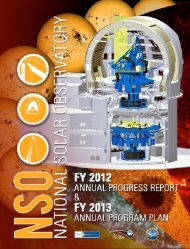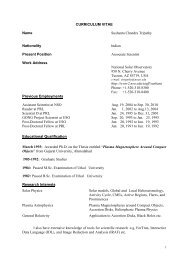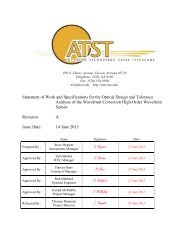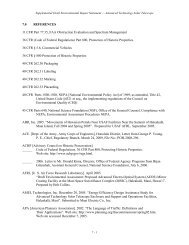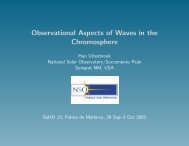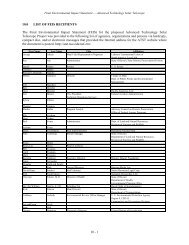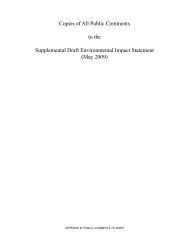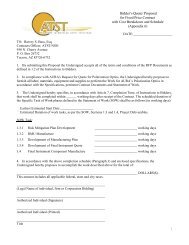F2 - ATST
F2 - ATST
F2 - ATST
You also want an ePaper? Increase the reach of your titles
YUMPU automatically turns print PDFs into web optimized ePapers that Google loves.
Cultural Surveys Hawai‘i Job Code: HALEA 2Traditional and Historic Backgroundtresses of hair, wrapped Māui in them, and cast him into the sea. The winds and storms becamehis home:Wave-uplifting gales nursed him, and at last threw him up on the shore, where hewas found by his great ancestor Tama-nui-ki-te-rangi, who carried him to his houseand suspended him from the roof, that the smoke and warm air might restore him;thus he grew up and his mother called him Maui-tiki-tiki-a Taranga, or “Mauiformed in the top-knot of Taranga”; his father Makea-tu-tara, at his baptism,omitted some of the Karakias [spells or incantations], and this caused Maui to besubject to death (Taylor 1870:124).Māui was raised as the youngest of six children. A precocious child, he would wait until hisfive brothers had finished a day’s fishing: “he would then throw his hook into the water, and atone pull catch more fish than they had all taken together.” Secretly, Māui had taken the jaw-boneof his grandfather Muri Rangawhenua, made a fish-hook of it, and kept it concealed as apowerful spirit-hook.One of Māui’s colossal works was tying the sun and moon together, so that having run theirdaily courses, they should return to their starting place. After Māui had forced the sun to travelmore slowly across the sky, thus increasing the length of the day, his name came to mean“Tama-nui-te-ra”, or “the great man day”.Hawaiki [Hawai‘i] were the islands seen as the cradle of Polynesia by the indigenous peopleof Aotearoa. From the original stories of the Maori come the legend that at one time, thetuawhenua, or the main land, was united all the way to Hawaiki [Hawai‘i] before Kupe came,cutting the land in two and allowing the sea to fill in between the two lands. Kupe was chief andmaster of the first canoe, named Mataorua, which brought the first migration from Hawai‘i tothe islands of Aotearoa.In the traditions of the Maori, the names of all seventeen canoes and the names of eachprominent family making the journey to Aotearoa are sacred. The canoe that carried Māui,Auraro tuia, was said to have been crafted by the master builder Tutaranaki. In the list of thetwenty-six generations of the Maori people, Māui is of the second generation, a demi-god rankedjust below that of the father of man, Tiki. In the traditions of the Maori, Tiki took red clay andkneaded it with his own blood, and so formed the eyes and the limbs, and then gave the imagebreath. In this way, Tiki made man in the image of himself.Hawai‘i is the name of the largest island in the Hawaiian Island Chain. In the language ofAotearoa, Hawai‘i is called Hawaiki tawiti nui, or the very distant Hawaiki. The legends of themigration of the Maori speak of Hawaiki pata, or nearer Hawaiki, (literally “the lesser isle”).This island, being smaller than Hawaiki, was the Maori name given to Tahiti. The legends speakof migrating islanders remaining in Tahiti until their numbers were too large for the size of theisland, causing a further migrations to Hawaiki i te moutere; or, the other islands of Polynesia(Taylor 1870).3.1.1.3 Legends Collected by Fornander (1919)Fornander states, “No demigod of Hawaii figures so prominently in Polynesian mythology asdoes Māui, nor the hero of so many exploits throughout these islands. This accounts for thevarious localities claiming to be his birthplace.”APPENDIX F (2): Supplemental Cultural Impact Assessment For the Proposed Advanced 16Technology Solar Telescope (<strong>ATST</strong>) at Haleakalā High Altitude ObservatoriesTMK (2) 2-2-07:008





